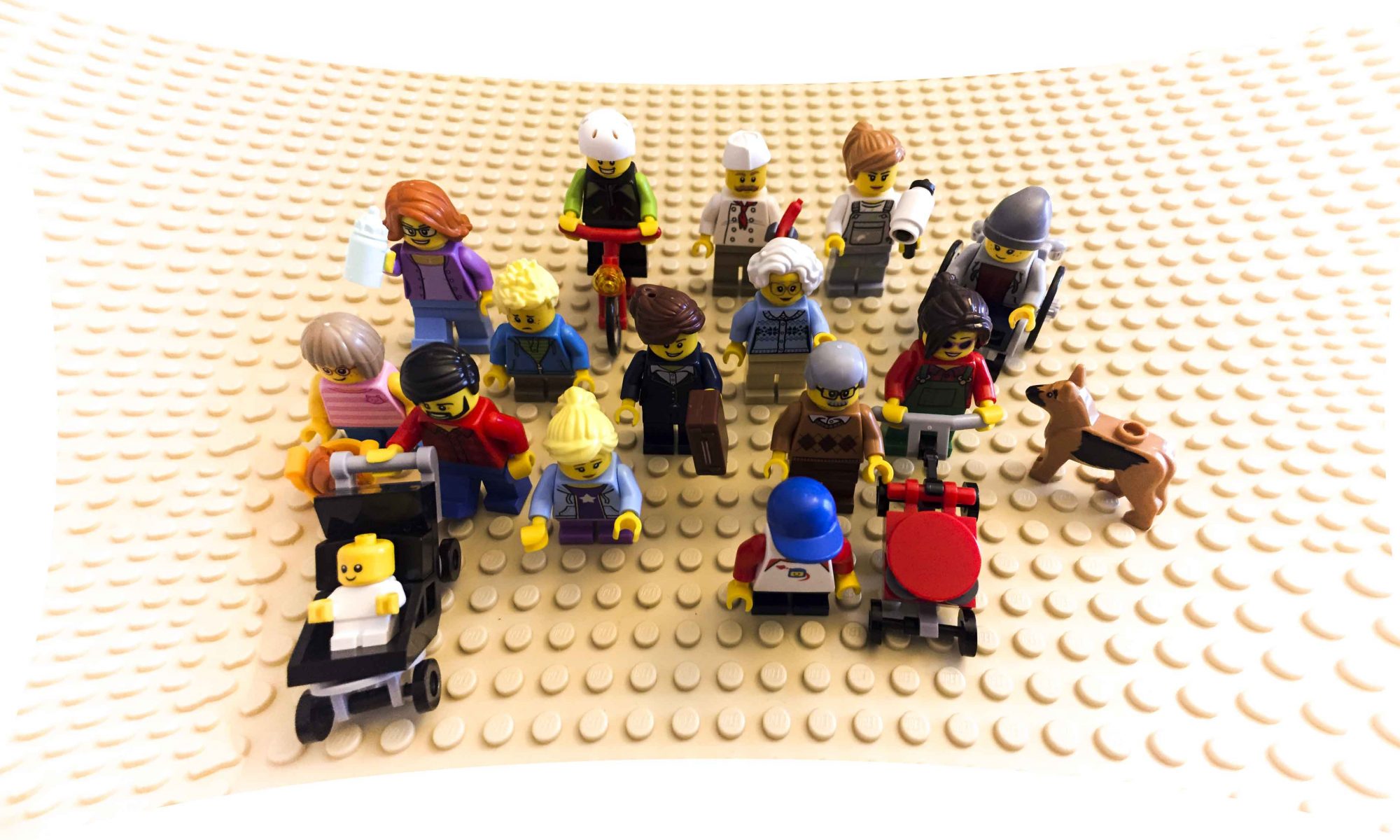Reading about agile, self-organizing teams I often think that diversity isn’t understood to its full potential. The Scrum Guide states that teams have to be cross-functional in order to „have all competencies needed to accomplish the work“ (Schwaber & Sutherland, 2016, p. 5). Most of the time „the work“ is addressed to be software development and testing. Diverse teams can do a lot more than that, as Management 3.0 suggests. But what is diversity?
For a photo project I bought some lego figures, „city people“, and at first sight I thought that they are not divers at all: I saw a lot of gender mainstreaming and stereotyping. There is a woman with a stroller and a bottle, an old woman sitting on a bench being given flowers from an old man, a man selling hotdogs and a badass man mugging a picknick table. But I was wrong: At a second glance I recognized that there was not only anti-stereotyping but even lots of diversity: There was a female painter, a female lawn mower and a female business woman. The badass man turned out to be a family father and in addition of gender and age there is also the dimension of handicap displayed by someone in a wheelchair.
The Wheel of Diversity Dimensions
Of corse, the real world is yet more complex than a lego city. The wheel of diversity dimensions by Loden and Rosener (1991) includes further internal dimensions like race, ethnicity and sexual orientation and also external dimensions like geographic location, income, personal and recreational habits, religion, educational background, work experience, appearance, parental and marital status. Having a diverse team means having people who show different dimensions of diversity and therefore have different strengths and weaknesses. Ideally they balance out each others weaknesses and amplify their strengths.
Where you have differences you have sources of friction. This can lead to creativity. Or to a shutdown. To prevent the later teams and organizational culture should embrace everyone taking them for what they are and respecting their uniqueness within the team. This is inclusion. It respects the individual within the whole. It proposes the chance to avoid groupthink: „Diversity increases perspectives and a potential for creativity and innovation.“ (Management 3.0)
I would add to that: If a team has to deal with special needs of each individual it makes them strong. They probably are more self-confident and independent. For them it becomes self-evident to include diverse people and diverse ideas. From my experience with teams in learning contexts people in diverse and probably not always easy situations have more self-awareness and do much better retrospectives of their team work. They know clearly about their strengths and about their weaknesses and how to overcome those last ones.
Diversity and the Management
At an event for exchange of experience I learnt what I suspected to be true for some time: One apparent diversity dimension tackled for years now is gender: women in leading positions (glass ceiling, see Wikipedia) and women’s salaries. Management often doesn’t seem to be to eager to respond to this dimension and it is the first and often only dimension that comes to mind. Even from women under the glass ceiling I often hear that these are old hats and that western society has overcome those problems by now.
What diversity experts of organizations say is: If you approach diversity explicitly on other dimensions than gender management seems to have more interest in it and especially under the premise of skill shortage (age-shift of the baby-boomer generation getting retired) diversity becomes exciting in dimensions as age and ethnicity / language. Somewhere economy has to find new qualified employees.
I am worried though that not for all diversity dimensions there is a quick solution: In a world where performance is everything, what happens to those who cannot keep up. What can they bring to a team that supports business value? Perhaps they will perform as motivators, communicators, mediators? Hopefully, self-organized team will come up with a way of inclusion that fits for everyone individually. What do they need? What tools could we give them? How can we support self-organization of diverse teams?
References
_ Marilyn Loden & Judy B. Rosener (1991). Workforce America! Managing Employee Diversity as a Vital Resource. Homewood: Business One Irwin.
_ Ken Schwaber & Jeff Sutherland (2016). The Scrum Guide.
